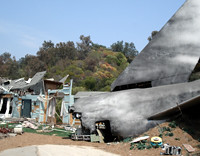Geoff Livingston, who pens The Buzz Bin, says the concept of "burying bad news and negative posts with a flurry of good news keeps coming up" again and again. He says it does on New Media Nouveaux and again online via an internal friend’s post at Pownce, which is a presence applicaton that allows you to send messages, links, files, and events to a defined network of friends.
Sure, I've seen this "bury bad news" tactic bantered about plenty: those who promote it (with qualified justifications) and those who do not (see rule 17). Some have even been suggesting that the Online Identity Calculator I employed on Thursday demonstrates why burying bad news and negative posts might work. It does not.
The argument for it is not new. It predates social media and is grounded in the argument that perception is reality. And there really is only one answer to whether that is true, um, sort of: yes and no.
In the world of communication (advertising, marketing, public relations, political consultation, etc.), people, products, and companies live and die by perception every day and all the time. But, to actively live with the mistaken belief that perception is reality is fraught with peril, delusion, and consequence.
For the past 25 years, I've nurtured what once was a .49 cent store-bought spider plant that has followed me from Las Vegas to Los Angeles to Las Vegas to Reno and back again. As you might imagine, after two-and-a-half decades, the plant has grown quite large — around 7 feet in diameter.
Anyone who visits my home is compelled to comment on the spider plant, usually something like "that is the largest spider plant I have ever seen" or "my goodness, your wife must really have a green thumb" (my wife always corrects them) or "you do a beautiful job at taking care of your plants, they are all so healthy."
Although several of these statement grace truths, all of them are really perceptions. Sure, I smile, nod, thank them, but never am I silly enough to believe that their perceptions, as welcome as they are, are grounded in reality. The truth is that my spider plant was in desperate need of a transplant; a pretty big job given the amount of soil and pot size. So despite its rich green color and vibrant leaves, I had been ignoring my plant much like some people ignore their personal brands.
The worst of it occurred while I was on holiday. One missed watering and record aridness (we are now the most arid city in the nation), prompted me to dig a little deeper past all the lush, beautiful green outer leaves to find, um, a crisis. While perception seemed to dictate everything was okay (except some minor bruises), the plant had three major problems: it had created a root layer that was preventing water from reaching the lower layers of the soil; the lower layers of the soil were bone dry as a result; and the plant had literally uprooted itself, with a good 3 inches exposed.
Fortunately, I am good with plants so I managed to save it. Of course, now it only measures 5 feet in diameter and will take a couple of days, if not weeks, to fully recover. I even potted all the babies to produce what will be another beautiful plant. So what does my plant have to do with personal brand?
You can bury bad news and negative posts all you want to create the illusion of a huge and beautiful online image, but sooner or later something will need to be done beyond burying damaged roots with big leafy stories.
Now I cannot go as far as Livingston does and say that all "bad news or negative posts" need to be addressed very publicly (every situation is dependent on too many factors to apply a formula), but I do agree that burying anything is an erroneous idea. As I mentioned when I shared the first sliver of my Fragile Brand Theory, brand damage is generally proportiate to the discrepancy between perception and reality.
Sure, I've seen this "bury bad news" tactic bantered about plenty: those who promote it (with qualified justifications) and those who do not (see rule 17). Some have even been suggesting that the Online Identity Calculator I employed on Thursday demonstrates why burying bad news and negative posts might work. It does not.
The argument for it is not new. It predates social media and is grounded in the argument that perception is reality. And there really is only one answer to whether that is true, um, sort of: yes and no.
In the world of communication (advertising, marketing, public relations, political consultation, etc.), people, products, and companies live and die by perception every day and all the time. But, to actively live with the mistaken belief that perception is reality is fraught with peril, delusion, and consequence.
For the past 25 years, I've nurtured what once was a .49 cent store-bought spider plant that has followed me from Las Vegas to Los Angeles to Las Vegas to Reno and back again. As you might imagine, after two-and-a-half decades, the plant has grown quite large — around 7 feet in diameter.
Anyone who visits my home is compelled to comment on the spider plant, usually something like "that is the largest spider plant I have ever seen" or "my goodness, your wife must really have a green thumb" (my wife always corrects them) or "you do a beautiful job at taking care of your plants, they are all so healthy."
Although several of these statement grace truths, all of them are really perceptions. Sure, I smile, nod, thank them, but never am I silly enough to believe that their perceptions, as welcome as they are, are grounded in reality. The truth is that my spider plant was in desperate need of a transplant; a pretty big job given the amount of soil and pot size. So despite its rich green color and vibrant leaves, I had been ignoring my plant much like some people ignore their personal brands.
The worst of it occurred while I was on holiday. One missed watering and record aridness (we are now the most arid city in the nation), prompted me to dig a little deeper past all the lush, beautiful green outer leaves to find, um, a crisis. While perception seemed to dictate everything was okay (except some minor bruises), the plant had three major problems: it had created a root layer that was preventing water from reaching the lower layers of the soil; the lower layers of the soil were bone dry as a result; and the plant had literally uprooted itself, with a good 3 inches exposed.
Fortunately, I am good with plants so I managed to save it. Of course, now it only measures 5 feet in diameter and will take a couple of days, if not weeks, to fully recover. I even potted all the babies to produce what will be another beautiful plant. So what does my plant have to do with personal brand?
You can bury bad news and negative posts all you want to create the illusion of a huge and beautiful online image, but sooner or later something will need to be done beyond burying damaged roots with big leafy stories.
Now I cannot go as far as Livingston does and say that all "bad news or negative posts" need to be addressed very publicly (every situation is dependent on too many factors to apply a formula), but I do agree that burying anything is an erroneous idea. As I mentioned when I shared the first sliver of my Fragile Brand Theory, brand damage is generally proportiate to the discrepancy between perception and reality.





















